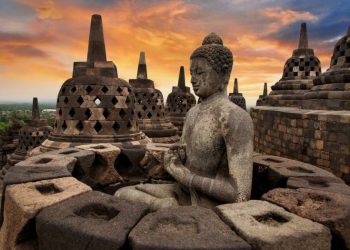Bandung, Indonesia Sentinel — On the southern part of Nias Island, Indonesia, a unique and ancient cultural tradition known as Fahombo or the “Stone Jump” continues to captivate locals and tourists alike. This centuries-old practice, performed exclusively by men, is most famously observed in the traditional village of Bawomataluo, located in South Nias, Indonesia.
Reside 324 meters above sea level, the name Bawomataluo translates to “Hill of the Sun” in the local Nias language, reflecting its elevated position. Here lies the tradition where young men leap over a stack of stones as high as 2 meters in a rite of passage that goes far beyond athleticism, it’s a test of their readiness to join the ranks of warriors, a tradition rooted in the island’s warlike past.
The Stone Jump tradition in Bawomataluo is a symbolic demonstration of physical prowess, a way for boys to prove they are prepared for adulthood. This ritual hold so much significance, that boys start training as early as the age of seven, gradually working their way up by jumping over ropes, wooden structures, and eventually, stone replicas of increasing heights.
Despite the years of training, Fahombo remains a dangerous feat. Many young men suffer injuries while perfecting their technique. Some believe that beyond physical preparation, mystical elements play a role in their success. It is widely thought that those who successfully clear the stone without touching it have been blessed by the spirits of their ancestors and the spirits of previous stone jumpers who have passed away.
Before attempting the jump, participants must seek the blessings of their ancestors, asking permission to perform the Fahombo in hopes of avoiding injury. This spiritual ritual underscores the deep connection between the people of Nias and their ancestral traditions.
A Tradition Steeped in History
The Stone Jump tradition dates back centuries, passed down from generation to generation alongside the island’s megalithic culture. Nias Island, covering 5,625 square kilometers with a population of around 700,000, is surrounded by the Indian Ocean, which has shaped both the geography and the history of its people.
Initially, Fahombo was more than just a coming-of-age ritual, it was born out of necessity during the frequent wars between villages on Nias. The people of Nias have a reputation for being fierce and strong, traits inherited from their warrior culture. In the past, conflicts between villages were common, driven by revenge, territorial disputes, and issues related to slavery.
To defend their villages, Nias tribes built tall stone or bamboo fortifications, often reaching 2 meters high. The Fahombo became a crucial part of a young warrior’s training, as the ability to leap over these barriers was essential in battle. The tradition evolved as a test for young men, with local aristocrats, or balugu, determining who was fit to become a warrior. The criteria were strict, only those who were physically strong, skilled in martial arts, and knowledgeable in black magic were deemed worthy. The final test required them to jump over a 2 to 2.5-meter-high stone wall without touching it. Even a slight graze meant failure.
Founder of TikTok Zhang Yiming, The Worlds 35th Billionaire
In the past, a successful Fahombo brought immense pride not only to the young men but also to their families. Celebrations were held, with families slaughtering livestock in honor of their son’s achievement.
While the wars between Nias villages are long over, Fahombo remains a vital cultural ritual and a symbol of Nias identity. Today, the Stone Jump is performed not as a preparation for battle, but as a celebration of the island’s heritage. It is often featured in cultural events alongside traditional war dances, which are reenactments of the island’s ancient conflicts.
For the people of Nias, Fahombo is more than just a physical test; it’s a link to their history, a tradition that honors their ancestors, and a testament to their enduring cultural pride. The ritual continues to draw visitors from around the world, offering a glimpse into a unique aspect of Indonesia’s rich cultural tapestry.
(Raidi/Agung)

























